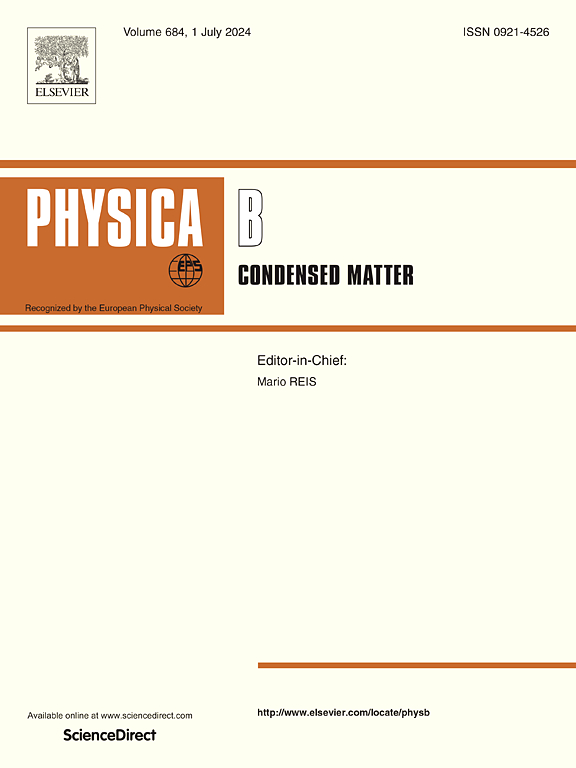柔性Janus HfFX (X = Cl, Br, I)单层中强垂直压电性:第一性原理研究
IF 2.8
3区 物理与天体物理
Q2 PHYSICS, CONDENSED MATTER
引用次数: 0
摘要
压电材料的发展受到对其内在机制的有限理解和相对较低的垂直压电性能的限制。本研究引入了Janus HfFX (X = Cl, Br, I)单层材料,并研究了其压电性能,揭示了垂直压电应变系数比其他Janus材料高出1-2个数量级。压电性能的增强归因于贝德电荷差和电负性差比,与所提出的P-R机制一致。此外,随着电负性差比的增加,压电性能有提高的趋势。增强的垂直压电响应也归因于强大的内置电场。此外,结果揭示了压电性和载流子输运之间的内在耦合,其中较低的极化电场与较高的空穴迁移率相关。这项研究不仅突出了HfFX单层膜在能量转换和触觉传感方面的潜在应用前景,而且加深了我们对二维材料中压电性的理解。本文章由计算机程序翻译,如有差异,请以英文原文为准。
Strong vertical piezoelectricity in flexible Janus HfFX (X = Cl, Br, I) monolayers: A first-principles study
The advancement of piezoelectric materials has been constrained by limited understanding of their intrinsic mechanisms and relatively low vertical piezoelectric performance. This study introduces Janus HfFX (X = Cl, Br, I) monolayers and investigates their piezoelectric properties, revealing vertical piezoelectric strain coefficients that exceed those of other Janus materials by 1–2 orders of magnitude. The enhanced piezoelectric performance is attributed to Bader charge differences and electronegativity difference ratios, consistent with the proposed P-R mechanisms. Furthermore, piezoelectric performance tends to improve with increasing electronegativity difference ratios. The enhanced vertical piezoelectric response is also attributed to strong built-in electric fields. Additionally, the results reveal an inherent coupling between piezoelectricity and carrier transport, where a lower polarization electric fields is associated with higher hole mobility. This study not only highlights HfFX monolayers as promising candidate applications in energy conversion and tactile sensing but also deepens our understanding of piezoelectricity in two-dimensional materials.
求助全文
通过发布文献求助,成功后即可免费获取论文全文。
去求助
来源期刊

Physica B-condensed Matter
物理-物理:凝聚态物理
CiteScore
4.90
自引率
7.10%
发文量
703
审稿时长
44 days
期刊介绍:
Physica B: Condensed Matter comprises all condensed matter and material physics that involve theoretical, computational and experimental work.
Papers should contain further developments and a proper discussion on the physics of experimental or theoretical results in one of the following areas:
-Magnetism
-Materials physics
-Nanostructures and nanomaterials
-Optics and optical materials
-Quantum materials
-Semiconductors
-Strongly correlated systems
-Superconductivity
-Surfaces and interfaces
 求助内容:
求助内容: 应助结果提醒方式:
应助结果提醒方式:


